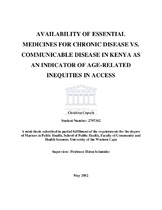| dc.description.abstract | Background: A growing concern about possible age-related inequities in health care access has emerged in the increasing debate on the challenges of population ageing and health in sub-Saharan Africa. Older persons may experience systematic exclusion from health services. Viewed as one of the poorest, most marginalized groups in SSA societies, older people are deemed to lack access to even basic,
adequate health care. There is an assumption, furthermore, that older persons have less access to required health services than do younger age-groups. This suggests an element of age-related inequity. One possible indicator of age-related inequity may be found through measuring the relative availability of essential medicines for chronic non-communicable diseases (NCD), relative to the availability of medicines for communicable diseases (CD). Aim and objectives:
The aim of the study was to compare the availability of essential medicines for NCD and CD in Kenya, as an indicator of age-related inequities in access to health care in Kenya. The three study objectives were as follows, in public and mission facilities in Kenya: 1. To assess the availability of medicines for the following CD: diarrhoea, HIV, malaria, pneumonia and other infections 2. To assess the availability of medicines for the following NCD common in older populations:
arthritis, diabetes, glaucoma, gout, heart disease, hypertension and Parkinson’s disease 3. To compare the availability of medicines for CD and NCD and draw conclusions on possible age-related inequities in access. Study design: Using an adapted version of the HAI / WHO methodology, a cross sectional descriptive survey of medicines availability was conducted. HAI and WHO collaboratively developed a standardized and validated methodology for comprehensively measuring medicines availability, as well as prices, affordability and price components. The survey manual, launched in 2003 and revised in 2008, is
available to the public. The methodology involves collecting data on the availability and price of medicines found in a sample of health facilities across sectors of interest within national health systems. If the specific medicine, dose and form being surveyed is available on the day of the survey, then the medicine is documented as being available. Methods: Random sampling was carried out in six of Kenya’s eight provinces, targetting ten facilities per province. Data on availability of the targeted medicines was collected by trained data collectors on pilot-tested data collection forms adapted from the standardized WHO / HAI methodology. The list of medicines included sixteen for communicable diseases to treat infections such as diarrhoea, HIV, malaria, and pneumonia and twelve medicines used to treat non-communicable diseases such as diabetes, arthritis, hypertension, gout, glaucoma, stroke and Parkinson’s disease. Availability of medicines was noted by physical observation by a data collector, and calculated as the percentage of facilities where a medicine was found on the day of data collection. The availability of brands and generics was not distinguished and were combined to establish availability of each medicine. Overall availability of all CD and NCD medicines was compared, and within each category between rural and urban areas and between mission and public facilities. The Ministry of Health was informed of the survey and provided the data collectors with an MOH endorsement letter. The names of facilities participating in the study were recorded on the data collection forms, but not reported. No data on individual patients was collected, and no patients were interviewed for this survey. Data were entered into an Excel file and exported to and analyzed with SPSS. Results: A total of 56 facilities were surveyed: 49 in the public sector and 7 in the mission sector, giving a facility response rate of 93%. Thirty facilities were located in rural settings and 26 were in urban settings. More CD medicines were available than medicines for NCD. Of a total of 896 individual observations of CD medicines, 632 (70.5%) were recorded as available on the day of visit, compared to 306 (45.5%) of 672 possible individual observations of NCD medicines. These differences were highly significant statistically (chi-square=98.8, p<0.001). Furthermore, comparison of availability
between urban and rural areas showed statistically significant differences for NCD medicines (40.6% vs. 51.3%, p=0.007), but not CD medicines (72.5% vs. 68.3%, p=0.190). There were no significant differences in availability of medicines in mission compared to public facilities. Conclusions: This study reveals the low relative availability of medicines for NCDs in Kenya’s public and mission sector. Medicines for NCDs were less available in rural vs. urban facilities, but there was no rural vs. urban difference in medicines for CDs. While more research should be carried out to understand the reasons behind these findings, immediate attention to the supply and financing of medicines for NCDs is urgently needed. The relatively lower availability of medicines for NCDs than for CDs may be an indicator of age-related inequities in access to health care in Kenya and calls for more
investigations on equity and access to health for older people in Kenya. | en_US |

